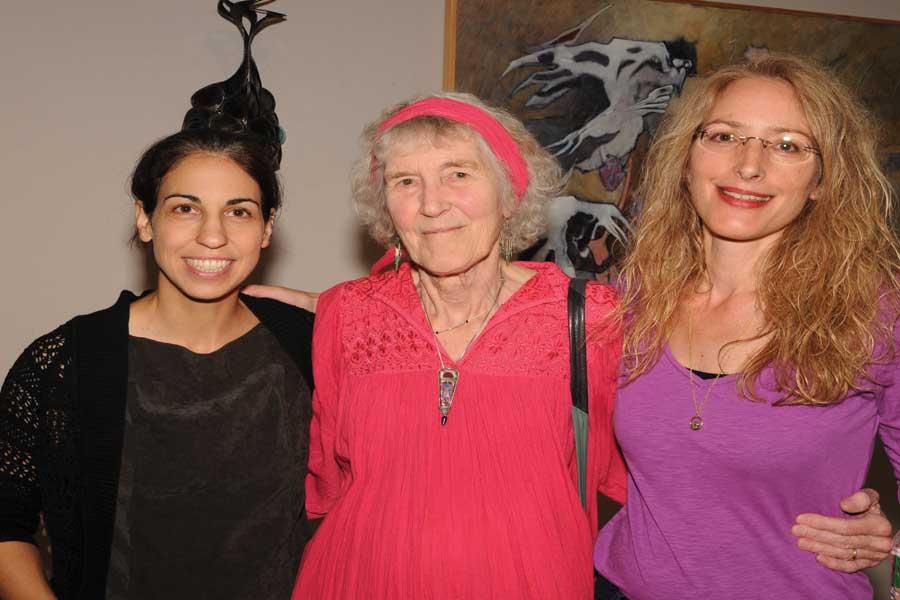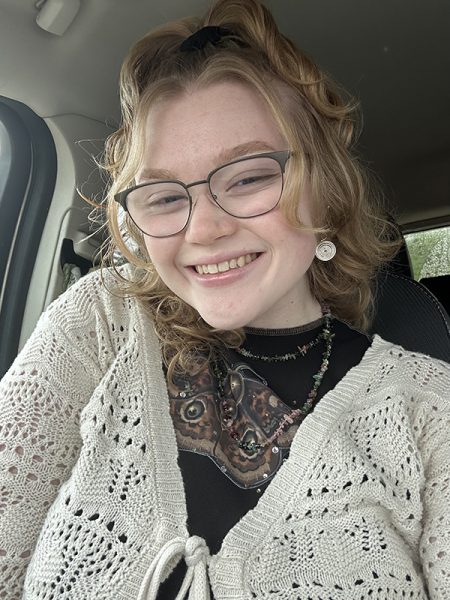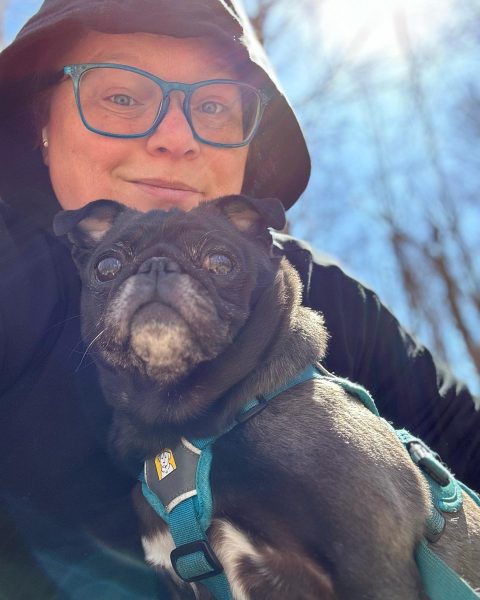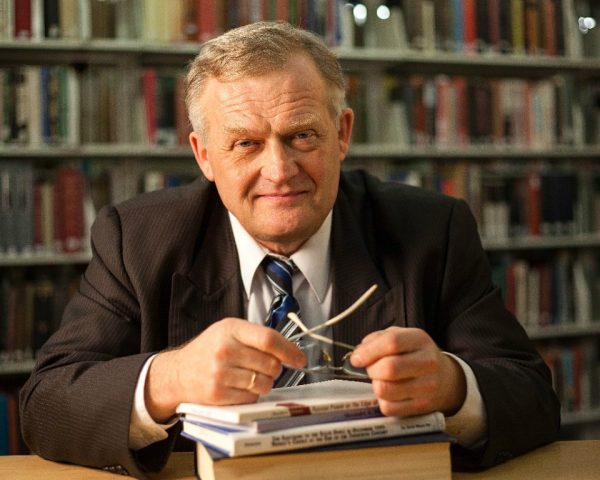The Hellers’ world: Dreams, horror and transformation
Leila Bandar, Alexandra Heller, and daughter Diane
Creatures made of steel are paired with large, dream-like oil paintings. They transform the Julian Scott Memorial Gallery into an atmospheric den capturing the majesty of the natural world, beautifying the love, mystery and horror of people.
The paintings are Peter Heller’s, who taught at Johnson State College in the art department for 20 years before his retirement in 1989. Peter worked in his studio until his death in 2002.
Peter was born in Berlin, Germany in 1929. His father was a Jewish composer and his mother a concert pianist. The family fled Germany during Hitler’s rise, eventually making their way to the United States.
Peter’s wife, Alexandra Heller, has been a sculptor for most of her life. She was born in 1932 and grew up in Groton, Mass. Alexandra met Peter at the School of Painting and Sculpture at Columbia University. The Hellers worked in various countries including Germany and Italy.
Alexandra taught sculpture at Johnson State College for five years during the ‘70s.
She owns the Brickhouse Bookshop at Morristown Corners, where she sells books and creates in her studio.
Alexandra visited JSC on Sept. 4 for a Q & A about her and Peter’s work. Heller spoke of the dreamscape quality of her husband’s paintings.
“They come from another realm,” she said. “To my mind they’re almost dreams come to life. I see a tremendous similarity to the very bewildering and confusing dreams human beings have.”
Many of Heller’s sculptures enact flight or movement. Some hang from the gallery’s ceiling.
“I’m always trying to get off the ground . . . and I think I’m headed for space,” said Heller.
Heller’s work looks different from every angle. Her sculptures seem alive. Many viewers walked in a 360-degree circle around her displays, at times taking two or three laps around a steel form.
“It’s an active experience, as opposed to a passive one,” one viewer said. “These sculptures become different creatures based on the degree you’re looking at them.”
Her piece “Turtle with Red Heart” hangs with its steel shell protecting a shimmering red orb of glass.
Her sculpture “Plantform” grows its long upward leaves around a tangled, intricate steel bulb in the center.
In-between two of Peter’s paintings is the stoic, sharp face of a creature inspired by a mandrill. Its crown spirals and twists out of control above its blue glass eyes.
Alexandra’s artist statement reveals her process from natural world inspiration to sculpture.
“Animals, Insects, Birds, Fish, Humans, Trees, Plants, Seeds, the Sun, Planets, Clouds, Fire . . . I find irresistible subject matter, I draw it until I have a more intimate acquaintance with it,” her statement reads.
Heller draws three versions of her subject: a realistic image, an abstract version to capture the beauty, essence and feeling of the original inspiration, and a version of the abstraction large enough to model her steel after. She then begins working with metal.
In her artist statement, Heller notes, “During this process the piece may change again in surprising and unplanned ways, sometimes becoming a combination of creatures springing from imagination and memory . . . the challenge remains the same – the transforming of hard cold steel into living organic forms. I never know what the final form will be. And I never know what it truly is until much later.”
Heller and audience members commented on the transformative quality of Peter’s work, how his paintings seem to change over time, in the span of minutes, and over years.
“That’s what you’re experiencing, and that’s what I’ve been experiencing for 10 years since he died,” said Heller.
Peter’s paintings are chaotic by choice and contain a magnificent energy. One painting can overwhelm and tighten the viewer’s chest, while another can calm and send the viewer into a haze. Peter chose to keep all of his work untitled to aid in the aliveness of his work.
Alongside Peter’s work is a collection of statements and excerpts from letters.
An obsession and love for paint radiate through his words: “I make love up here everyday. I mean, of course, the fusion of brush and canvas, of power and gentleness, of mind and feeling, of male and female, of forms dancing and merging. The thought that it is possible to bring back to the canvas the kind of love which painters have always had for their canvases, for every creature, for every form of life, drives me onward.”
Peter’s words also address art’s role in society: “A single, beautiful, powerful object made by human hands is more important to the race than all the presidents of China, or the mayors of Oshkosh. One look at the work of the pre-Columbians in Mexico, or Peru, and somehow everything else falls by the wayside. Without the arts there is silence.”
Alexandra interrupted an audience member who pondered the connection between her piece “Peter’s Ear” and the man’s ability to be a supreme listener. “[It’s] none of that,” said Heller. A dozen people laughed at her sharp enthusiasm. “He had a beautiful ear . . . that’s it,” she said.
Heller was very comfortable near her work and people.
A former coworker of Peter revealed that years ago Peter said he was trying to express his feelings concerning the holocaust through some of his paintings.
Alexandra’s daughter Diane was also present. “When there are such horrible things happening, how do you make sense out of it?” she asked. “It’s very difficult to use words to talk about the most obvious things such as murders and annihilation . . . instead he can deal with that through imagery . . . and how do you transform that in a way that it holds the weight of the subject matter but [has] a beauty of the forms? That’s art, to me.”
Director of the Julian Scott Memorial Gallery Leila Bandar is responsible for bringing the Hellers’ work to JSC.
The relationship between the two has inspired Bandar in her own work as an instructor and sculptor.
“Working with her is amazing . . . you feel like you’re around good luck, you feel like things are just possible,” said Bandar.
Bandar feels her role as director is to provide opportunity for fellow artists to display their collections.
“When an artist does create a body of work, I think there is kind of a leap of faith that you make these things, and you put yourself into it and you don’t know how it’s going to last or endure,” said Bandar.
This exhibit is open to the public weekdays and Saturdays from 10 a.m. to 6 p.m. Additional paintings are in the Dibden Wings Gallery and can be seen from 8 a.m. to 8 p.m. weekdays and Saturdays.
The exhibit will carry on through Sept. 24.
Travis LeClair joined the Basement Medicine staff in Spring 2014, assuming the position of staff reporter.






